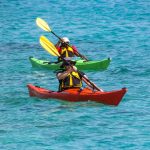Thousands of years ago, Indigenous Arctic people navigated the seas in kayaks. These Sea kayaks were made of hides stretched over wood or whalebone.
Sea kayaking adventures bring with them a feeling of peace. You can leave your chaotic daily lives onshore and let the water take you.
Interested in giving it a go?
Here’s our guide to getting started…
What Is A Sea Kayak?
I know you’re going to make this wrong assumption – even some experienced kayakers do – so I figured I should address the misconception straight away:
A sea kayak is not equivalent to a touring kayak.
I understand why people might think that their long and thin hulls and smooth outlines look the same. It is reasonable to assume that many touring kayaks can be taken out on the ocean – however, not all of them are suitable for use in saltwater.
What is the distinction between a kayak and a sea kayak?
It appears to be a rather oddly phrased query, I apprehend, yet you understand what I am implying by it. This term “kayak” could be applied to a wide range of vessels that are not specifically sea kayaks, including recreational boats, all-purpose kayaks, and whitewater kayaks.
Sea kayaks are typically long and thin, featuring a V-shaped bottom and sealed compartments that provide plenty of storage for items. The structure of these boats is strong enough to take on choppy, open waters.
You will usually observe them fitted with a skeg or rudder apparatus – though typically they supply steady navigation capabilities on their own as well.
Sea kayaks are costly due to the fact that they are designed for open water navigation and can withstand difficult conditions; it’s best to think of them as an investment. I’d suggest buying from a well-
How Hard Is Sea Kayaking?
I will presume that you are not a beginner and that you have experienced quite a few canoeing experiences on a regional lake or stream close by. If I’m correct, it follows that since you are accustomed to kayaking on a river with drops, stones, and strong currents, you might imagine that the ocean would not have anything to offer in the way of a “Wow” moment.
What is so exhilarating about having an environment that is all blue in sight? Mesmerizing, sure – but adrenaline-fueling? Not so much.
That’s where you’d be wrong. Oh-so-horribly wrong.
Sea kayaking is not an easy activity that doesn’t require any preparation. Sea kayaking may turn out more demanding than anticipated, due to a large number of likely difficulties that may arise.
Here are a few:
- Varying Water & Weather Conditions – You’re facing all the challenges of open waters at once. Series of waves, strong winds, powerful currents, tides – all without any shelter in sight. And the fact that the conditions can change in a matter of minutes doesn’t make it any easier.
- Requires A Certain Level Of Fitness – Surprise, surprise, you actually have to paddle when you’re out on the sea. The moment you stop, you’re leaving room for currents and winds to take over. It’s an endurance sport in every sense of the word – and you’re going to feel the strain by the end.
- Maneuvering Requires Advanced Skills – Sea kayaks are long, pointy, slender – and a real pain to maneuver without advanced paddling skills. “Stick your paddle’s blade in the water and pull” is nowhere near enough to pull this off successfully – let alone safely.
- Goes Beyond Just Paddling – Mastering essential skills and knowing what you’re doing paddling-wise is one thing. But sea kayaking requires skills that go beyond swinging that paddle of yours. Marine navigation, water safety and survival skills, and the basics of marine communications and emergency procedures, such as using a VHF radio to make a distress call, are all skills you have to master.
Dangers Of Sea Kayaking: Is Kayaking In The Ocean Dangerous?
If you’re wondering what the answer is, you likely already have an inkling of what it could be. It won’t be an easy task, however that can come across as too dreary.
Kayaking in the sea does not usually pose a high risk to those who partake in it.
As long as the weather is favorable and the currents are cooperating, it is usually quite secure to go kayaking in the ocean. But we both know, things are rarely ideal.
You should be aware of the potential risks and hazardous situations that could occur while you are out at sea.
Here are a few common dangers of sea kayaking to keep in mind:
- Weather – You’d be surprised how quickly strong winds, lightning storms, rain showers, and dropping temperatures can change a casual afternoon paddle into a life-threatening situation. The ocean is unpredictable – and the weather can be, too. The conditions can turn in a matter of minutes.
- Extreme Cold & Heat – Make no mistake about it; both can be deadly when you’re out on open water. Too cold, and you’re at risk of cold shock and hypothermia. Too hot, and you’re at risk of heat exhaustion and heatstroke.
- Rough Waters & Currents – One thing you should never do is undermine the power of the open waters. Again, the ocean is unpredictable. You’ll be going against rip currents, series of large waves, changing tides – all of which will try to throw you off your course.
- Boat Traffic – You’re not on a nearby lake; chances of encountering other boats – often much larger than your kayak – are pretty high. You might be able to see them from afar, but the real question is – will they be able to spot you and your plastic boat?
- Getting Lost At Sea – The mere thought of it sounds terrifying, doesn’t it? The thing is, it can be hard to maintain any sense of direction and keep track of how far you’ve paddled when there’s no shore or landmarks in sight.
- Sharks – Yes, yes, shark attacks are not as common as one might imagine – but they do happen. While you shouldn’t let your imagination run wild or let your fears get the best of you, you should be aware that encountering a shark is a genuine possibility. You paddled your ‘yak straight into their front yard, after all.
Acquiring a first kayak can be a daunting experience for any novice paddler. Kayaks are purposely intended for various purposes, and as you can learn all the needed capabilities with any kayak, possessing one constructed especially for your pursuits can be very helpful when you are just beginning to learn.
These are some suggestions that may be useful to you as you determine which kayak will be most suitable for you.
First, let’s look at the three basic types of kayak:
Creek kayak
A creek kayak is typically a kayak with a lot of room around the chair position, and the volume is balanced evenly. The larger designs of decks make sure that neither side of the kayak goes underwater easily, with the entire vessel being made to be able to resurface quickly.
These boats have a notable amount of curve in the bottom of the hull which allows for quick turns. Short tips are used to prevent vertical pins. Creek boats may have slight edges along the bottom. These “chines” provide great maneuverability, making it easier to complete tighter turns in eddies.
The size of creek kayaks differ based on where they are meant to be used, usually being longer than either types of play kayaks or river runners.
Play kayak
Play kayaks are mainly utilized for surfing waves, entering holes and doing freestyle stunts. They generally feature a much lower measure of volume on the front and stern decks, which make them unsuitable for running rivers without having enough background in this area.
The flattened decks enable the edges to go under the water, so canoeing enthusiasts can do vertical moves. A substantial amount of total space being concentrated near the control station guarantees equilibrium in this upward direction.
At present, kayaks used for play have an exceedingly flat hull in order to make them able to slice the water when they build momentum. When sailing, the kayak can rotate around a focal point. On waves, this is what makes flat-spins possible.
In shallow water, the design of the hull gives more precise maneuverability and direction control. Chinese can be used to carve and create drag so that the rower can purposely prepare for a certain rodeo maneuver.
Downriver kayaks
Kayaks that are positioned between those designed with a lot of water flow as well as those created solely for recreational purposes are referred to as downriver kayaks. These kayaks are designed to enable people to take a leisurely voyage along the river comfortably and with precision.
And also with features that enable some basic enjoyable activities. Kayaks that sail downriver have bows with medium to large amounts of water that wash off quickly and sterns with medium to little amounts of water.
The majority of designs will likely be bigger in size than conventional freestyle designs. By extending the boat’s length, it will be able to move in a more stable manner and will be able to pick up speed as it moves in a forward direction.
Kayak Volume
The inner capacity of a kayak, usually measured in gallons. The style of boating you desire will determine which volume of boat is best for your needs.
High-volume
High-volume boats have “ballooned” ends and resurface quickly. This is a good opportunity for novice kayakers and those experienced in running faster rapids and waterfalls. The large and curved decks on the bow and stern of the boat help it to rapidly shed water, ensuring that it stays afloat.
Low-Volume
Boats with a smaller capacity have shallow and occasionally indented decks at the front and back, leaving little room within the stern and bow.
This slender shape permits the bow and stern to penetrate the liquid, thus making the current freestyle stunts achievable. In rough whitewater, though, powerful whirlpools can easily run over the deck, decreasing both speed and maneuverability.
Hull
The shape of the bottom of the boat. Manufactured as a displacement or planing hull.
Displacement hulls
The bottom of a boat is traditionally formed into a displacement hull. Normally, the outline and shape of the hull have a continuous pattern of curves. Ships with displacement hulls travel efficiently through the water because of their curved, aerodynamic design. Due to the center line at the bottom of the hull, displacement-hull boats feature a keel, thus traveling straight more easily.
Planing hulls
Planing hulls have a bottom that is leveled off, and the sides rise from the bottom at a specified angle. When not moving quickly or when actively being paddled at a slower pace, planing-hull boats cut through the water. When the boat is put in motion, its flat surface glides across the water, making it easier for the boat to turn. Despite the boat’s capacity to make sharp turns, it is hard for someone using a paddle to keep its trajectory linear.
Chine
The line where the boat’s bottom and sides join is called the chine. Described as either hard or soft, chines define the shape of the hull as either boxy or rounded.
Hard Chines
Tough chines extend control for cutting and make it possible for the boat to still plane even when the direct is shifted to the side or when rotating. However, the boat can be flipped quickly and unexpectedly due to sharp edges.
The function of a chine is global, but there are a wide array of designs and models of chines that fit different boats. An ideal 90-degree chine would produce the top results; however, most people would find them too hard to manage.
Recent designs are trying to achieve a balance between high performance and leniency. Do not let fear stop newcomers from piloting boats with hard chines as they need awareness and skill, but it can still be done.
Gaining proficiency in a current style of kayak can help with body movement and improve your knowledge of rivers.
Soft Chines
Smooth curves on a boat provide a smoother experience where there is nothing for the water to snag onto. Boats that do not have a sharp edge provide less of an ability to carve through the water, but they can provide a more reliable response when the hull is close to shallower parts of a river.
Soft edges glance off rocks without catching. Edges with a pointed edge are liable to scoop up stones which can make the vessel turn backward or take it off in an erratic course.
Rocker
The curve from bow to stern on the bottom of the boat. Comes in two styles; Kick and Continuous.
Kick Rocker
The point at the center of the undersurface of the rocker is virtually level, while the edges of it incline sharply. This creates a disc surface which is small and level that stays on top of the water and keeps the edges up out of the liquid, making it more uncomplicated to perform tricks.
Continuous Rocker
A continuous rocker is a type of bottom which is curved in one uninterrupted fashion from one end of the board to the other. The shape of the bottom helps reduce the amount of the boat that touches the water, allowing for faster turning and greater control.
Using a consistent, rocking motion can assist in carrying out a “boof,” a technique often used to navigate a rocky, shallow descent.




